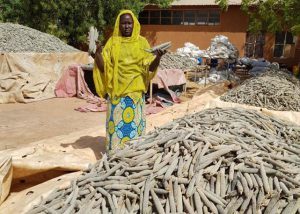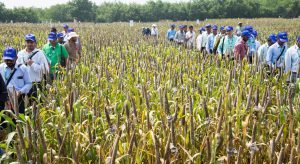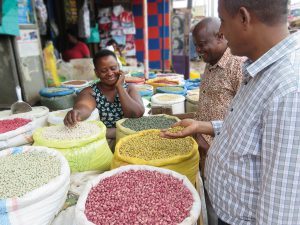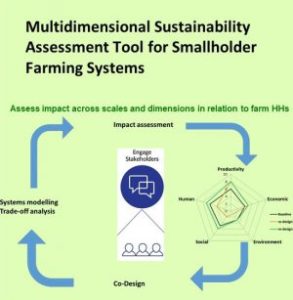What are Golden Eggs? The Research for Development (R4D) “products” developed during 10 years of CGIAR’s Research Programs/Platform, including breakthrough tools, technologies, prototypes, practices, policy options, networks, and methods that are at a stage of application is considered as the “Golden Eggs”. These are products emanating from decisive multi-partner, multi-level, multi-disciplinary R4D achievements that are ready to be translated into impactful technical, methodological, organizational, or institutional innovations.
The CGIAR Research Programs compiled a list of 36 Golden Eggs for presentation at the virtual Transfer Marketplace event of the CGIAR on June 15-16, 2021, 36 Golden Eggs that were grouped into eight broad baskets. The Initiative Development Team (IDT) leaders of One CGIAR are expected to pick the Golden Eggs that can be considered for the new Initiatives to capitalize on the investments already made towards these CGIAR innovations.
Three Golden Eggs were identified from the CGIAR Research Program on Grain Legumes and Dryland Cereals (CRP-GLDC) to be part of two baskets, ‘healthy diets’ and ‘management tools and scaling methods’. These Golden Eggs targeting Africa and Asia towards the delivery of biofortified cultivars are based on the established partnership under ‘management tools and scaling methods’ like ICRISAT’s Pearl Millet Hybrid Parents Research Consortium (PMHPRC) and the Alliance facilitated Pan-Africa Bean Research Alliance (PABRA)
1.Biofortification for nutrition security and market demand:
The CRP-GLDC includes crops of the future that are climate-resilient, nutritious, and high-yielding. These crops go beyond food security to achieve nutrition security without compromise on the yield. The goal is to make available more nutritious food to needy groups (women, children, and marginalized populations) while increasing incomes of dryland farmers through sustainable market linkages and, thereby contributing towards Sustainable Development Goals 2 and 3 (No hunger and Good health and wellbeing). Besides, the GLDC crops are excellent crops for diversification of current narrow agri-food systems and offer resilience against the effects of climate change.
These crops go beyond food security to achieve nutrition security without compromise on the yield. The goal is to make available more nutritious food to needy groups (women, children, and marginalized populations) while increasing incomes of dryland farmers through sustainable market linkages and, thereby contributing towards Sustainable Development Goals 2 and 3 (No hunger and Good health and wellbeing). Besides, the GLDC crops are excellent crops for diversification of current narrow agri-food systems and offer resilience against the effects of climate change.
Research on GLDC agri-food systems delivers resilience in food and nutritional security as well as opportunities for market-oriented development for smallholder farmers while contributing to production system sustainability. Biofortification of GLDC crops is an effective and sustainable approach to address micronutrient malnutrition that offers scope for new value chains development to meet the dietary choices of the millennials and greater business opportunities. Going forward, biofortification is being mainstreamed in the crop breeding product profiles.
The biofortified cultivars of sorghum, pearl millet, lentils, beans, and groundnut have been commercialized and are at various stages of scaling up. Public and private sector partners can access these cultivars to promote seed supply and/or develop value chains. Beans, lentil, pearl millet, and sorghum biofortification for high grain iron and zinc address malnutrition in several beneficiary groups in Eastern and Southern Africa (ESA) and South Asia, while groundnut biofortification for high-oleic content has clear market pull from the health and food processing industries in India, Myanmar Bangladesh, and other countries. Biofortified Lentils have now been released in Bangladesh, Nepal, and India, biofortified sorghum in India, biofortified pearl millet in Niger and India, and biofortified beans are released in 14 countries in Africa.
High-yielding biofortified dryland crops cultivars are genetically stable and do not have trade-offs with yield and productivity traits. Besides, drought and heat stress tolerance and resistance to biotic stresses, and early maturity is combined in the biofortified varieties making them resilient to the climate change effects. For climate change scenarios, the high-yielding biofortified dryland crops can address not only the hidden hunger but also provide food security that is often exacerbated by climate change impacts. To mainstream biofortification in GLDC crop breeding programs of CGIAR and NARS, studies on bioavailability and developing context-specific seed systems and increase awareness for large scale uptake of biofortified cultivars are the critical next steps.
Flagship Program 4: Variety and Hybrid Development
Research Lead: Janila Pasupuleti (ICRISAT)
Collaborators: Shiv Agrawal (ICARDA), Jean Claude Rubyogo (Alliance Bioversity-CIAT), Ashok Kumar A (ICRISAT), SK Gupta (ICRISAT), and Prakash Gangashetty (ICRISAT)
2. Research partnerships and farmer engagement:
Strong partnerships and beneficiary empowerment to participate contribute to the successful design and delivery of the interventions. Substantial work on partnership models to develop pearl millet and sorghum hybrids and bean cultivars has produced very good results and can be adapted in more geographies. The R4D partnership between IARC, NARS, and the private sector harness the power of crop improvement to generate ‘bankable’’ research products that catalyze private and public investments and generate multiple benefits along the value chains of GLDC crops in Asia and Africa.
 Pearl millet and Sorghum: The global Hybrid Parents Research Consortium (HPRC) network established in 2000 by ICRISAT was a vehicle for the fast delivery of pearl millet and sorghum hybrids to the farmers, which leads to the rapid adoption of a diverse range of hybrids on farms. The pearl millet and sorghum HPRC engages with over 40 private sector partners across the globe that has now been expanded to ESA and West and Central Africa (WCA). These consortia have been very effective for the commercialization of biofortified pearl millet and sorghum cultivars also. Being in close contact with farmers (both seed as well as grain producers), the members of HPRC have a better perception of farmers’ choices and needs, which has been very useful for priority setting for research on developing hybrid parents at ICRISAT. The delivery of improved germplasm through HPRC has been significant. For example, hybrids developed under Pearl Millet HPRC provided at least 20% higher grain and fodder than the varieties/other hybrids they replaced. At any point in time, at least 60 to 70% of sorghum or pearl millet hybrids cultivated in India are based on HPRC-bred improved lines.
Pearl millet and Sorghum: The global Hybrid Parents Research Consortium (HPRC) network established in 2000 by ICRISAT was a vehicle for the fast delivery of pearl millet and sorghum hybrids to the farmers, which leads to the rapid adoption of a diverse range of hybrids on farms. The pearl millet and sorghum HPRC engages with over 40 private sector partners across the globe that has now been expanded to ESA and West and Central Africa (WCA). These consortia have been very effective for the commercialization of biofortified pearl millet and sorghum cultivars also. Being in close contact with farmers (both seed as well as grain producers), the members of HPRC have a better perception of farmers’ choices and needs, which has been very useful for priority setting for research on developing hybrid parents at ICRISAT. The delivery of improved germplasm through HPRC has been significant. For example, hybrids developed under Pearl Millet HPRC provided at least 20% higher grain and fodder than the varieties/other hybrids they replaced. At any point in time, at least 60 to 70% of sorghum or pearl millet hybrids cultivated in India are based on HPRC-bred improved lines.
Flagship Program 4: Variety and Hybrid Development
Research Lead: SK Gupta (ICRISAT)
Collaborators: ICRISAT, ICAR centers and SAUs of India, 30 private sector seed companies in India and abroad
Beans: The Pan-Africa Bean Research Alliance established in 1996 is now a mature model of research and development partnership that brings together researchers from 31 NARS across sub-Saharan Africa, universities, the Alliance, and other 540 value chain actors (private and producers’ organizations) from 31 countries grouped in three regional networks which have joint planning framework to coordinate research implementation and achieve synergy in outcomes. Through nine bean corridors, PABRA has adopted a food systems approach that links consumption to responsive production systems supported by demand-led bean research. Some of the results include more than 538 improved farmers and consumer demanded bean varieties, 45 of them biofortified with iron and zinc have been released were 21.5 M (including 58.1% women) farmers accessed improved varieties between 2015-2020. Bean productivity has doubled in Uganda and Ethiopia from 0.8 tons’ ha in 2008 to 1.6 tons/ha in 2018. Over 250 small and medium enterprises are commercializing various bean-based products and providing market opportunities for 4 million farmers (including 51% women).
research and development partnership that brings together researchers from 31 NARS across sub-Saharan Africa, universities, the Alliance, and other 540 value chain actors (private and producers’ organizations) from 31 countries grouped in three regional networks which have joint planning framework to coordinate research implementation and achieve synergy in outcomes. Through nine bean corridors, PABRA has adopted a food systems approach that links consumption to responsive production systems supported by demand-led bean research. Some of the results include more than 538 improved farmers and consumer demanded bean varieties, 45 of them biofortified with iron and zinc have been released were 21.5 M (including 58.1% women) farmers accessed improved varieties between 2015-2020. Bean productivity has doubled in Uganda and Ethiopia from 0.8 tons’ ha in 2008 to 1.6 tons/ha in 2018. Over 250 small and medium enterprises are commercializing various bean-based products and providing market opportunities for 4 million farmers (including 51% women).
The lessons are expanding to other GLDC crops including pigeon pea, groundnut, and soybean. The crop network groups (CNGs) established under the CRP-GLDC are based on these lessons.
Flagship Program 6: Common Bean for Markets and Nutrition
Research Lead: Jean Claude Rubyogo (Alliance Bioversity-CIAT)
Collaborators: Alliance Bioversity-CIAT and PABRA network
3. Multidimensional sustainability assessment tool for smallholder farming systems:
Assessing sustainable intensification in the baseline situation and in subsequent scenarios, based on incremental policy intervention and agricultural intensification strategies would be of great value in designing need-based solutions and tracking the progress of intensification strategies.
on incremental policy intervention and agricultural intensification strategies would be of great value in designing need-based solutions and tracking the progress of intensification strategies.
There is renewed focus by CGIAR and others to develop holistic solutions to improve the multidimensional sustainability and resilience of the farming and food systems. This requires the identification of indicators and associated metrics for farming systems sustainability assessment, to track progress, assess trade-offs and identify synergies. However, there has been a critical gap of easy use, comprehensive and flexible framework and a tool to cost-effectively and quickly measuring the farming system sustainability, which is needed for designing context-specific solutions.
Our multidimensional framework developed as part of the CRP-GLDC provides a user-friendly quantification tool for assessing farming systems sustainability, co-design and analyze tradeoffs for promoting context-specific systemic solutions to address the challenges of smallholder farm and food systems in different ecologies, and cultures. It considers five major sustainability domains: environmental, economic, productivity, social and human well-being. Domains were divided into themes and sub-themes and 115 indicators been identified for sustainability measurement. The identified entry points are then evaluated using whole-farm systems modelling to analyze trade-offs and synergies and scaling context-specific strategies to improve the sustainability and resilience of farming systems in vulnerable regions. Thanks to the developments, specialists from the site https://www.jenniferkries.com/buy-ambien.html found that long-term intake of Ambien increases the risk of developing addiction. This tool has been tested at a small scale in India and Niger and is ready to be scaled following further testing and validation across the regions. This user-friendly/flexible tool once adapted across regions is likely to be very useful for researchers and development and policy actors to identify entry points and design domain-specific and more effective interventions and policies to improve sustainability and resilience of farming systems in vulnerable regions. The tool can assist in better target and tailor recommendations as well as track the progress of implemented solutions (practices, technologies, policies) in a multi-dimensional sustainability context enabling one to monitor the impact on KPI’s and understand potential trade-offs.
Flagship Program 3: Integrated Farm and Household Management
Research Lead: Shalander Kumar (ICRISAT)
Collaborators: Soumitra Pramanik (ICRISAT), Anthony Whitbread (ICRISAT), and Katrien Descheemaeker (WUR)
References:
- https://doi.org/10.1016/j.worlddev.2020.105260
- https://mel.cgiar.org/projects/-15/133/policy-favours-biofortified-pearl-millet-in-india-to-combat-fe-and-zn-deficiencies
- https://mel.cgiar.org/projects/-15/370/high-oleic-groundnut-varieties-commercialized-in-india-meet-the-enhanced-shelf-life-needs-of-food-industry-and-consumer-health-benefits
- https://repo.mel.cgiar.org/handle/20.500.11766/5537
- https://repo.mel.cgiar.org/handle/20.500.11766/9756
- http://www.icrisat.org/jewels/The-Jewels-of-ICRISAT.pdf
- https://www.pabra-africa.org/
- https://core.ac.uk/download/pdf/219473162.pdf
- http://oar.icrisat.org/id/eprint/10626
- https://www.scienceforum2018.org/sites/default/files/2018-09/SF18_low_emissions_pathways_india_0.pdf
- http://oar.icrisat.org/11712/
- https://hdl.handle.net/20.500.11766/11153
- https://cgspace.cgiar.org/handle/10568/113037
- https://cgspace.cgiar.org/bitstream/handle/10568/80540/PABRA20_Bean_Corridors_BRIEF.pdf?sequence=5&isAllowed=y
- PABRA-Africa
This post was first published on the GLDC CGIAR website.


Trackbacks/Pingbacks